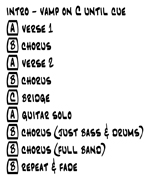Hey frustrated rock and rollers, country pickers
and blues people! Want to write your ideas down, but feeling daunted
by the whole music notation thing? Borrow something way useful and
not so intimidating from your friends in the jazz world:
Rhythmic notation!
First we'll start with the simplest way to write out a song:
chord charts in slash notation
You can think of rhythm as a regular way of dividing up time.
The basic units of rhythm are bars and beats. Nearly all music
made in America is in 4/4 time, meaning that each bar contains
four beats, which you would count "one, two, three, four."
You can also group bars together into sections or phrases. Sections
include things like verses, choruses, intros, etc. A phrase is
more like a single line of a song. Phrases are usually two, four,
eight, sixteen or thirty-two bars long, although you also frequently
see twelve and twenty-four bar phrases. Sections are usually eight,
twelve, sixteen, twenty-four or thirty-two bars long.
Here's a typical four-bar phrase in 4/4 time. It's sixteen beats
of C major. Each slash in the first bar stands for a beat. The
% signs mean "repeat what you did in the previous bar."
The squiggly thing on the left is a treble clef, which you can
ignore.

Usually you should write your chart in four-bar phrases, since
it's the easiest way to read music. It's a good idea to assign
a letter name to each section, like so:

Different people mean different things by the terms "bridge",
"pre-chorus," "instrumental", "break"
etc, and having letter names saves endless confusion.
You can also use the letter names as a convenient way to think
about song structures. A typical pop song with an intro, a few
verses and choruses, a bridge, a solo etc might look like this:

repeats
Below is a four-bar phrase with repeat markers. When you get
to the end of a repeated section, loop back to the opening repeat
marker.

repeats with endings
A common method to make charts of repetitive tunes more readable
is to use repeats with different endings. In the example below,
you play the first ending three times (meaning you repeat the
four bar phrase.) On the fourth time, you go to the second ending
(and the song continues on after that.)

rhythmic notation
note values
A whole note takes up an entire bar of four beats. Half notes
take up half a bar, so they're two beats long. Quarter notes are
one beat, eighth notes are half a beat, and sixteenth notes are
a quarter of a beat. Typically you count on all of the eighth
notes: "One and two and three and four and."

Each beat within a bar has a name.
- Beat 1 is called the downbeat, so named because conductors
wave their batons downwards to signal the beginning of each
measure.
- Beat 3 is called the backbeat. The signature sound of rock
and roll is a hard accent, like a snare drum hit, on every backbeat.
- Beats 2 & 4 are where you snap when counting jazz, country,
blues and any other music that swings.
- The weak beats are the "ands" - and of 1, and of
2, and of 3, and of 4. Syncopation is the term for rhythms that
emphasize the weak beats. Jazz, funk and Afro-Cuban music use
heavy syncopation.
rests
A whole rest takes up an entire bar of four beats. A half rest
is two beats, a quarter rest is one beat, an eighth rest is half
a beat, and a sixteenth rest is a quarter of a beat.

Goofy but useful mnemonic device: Whole rests drop below the
line like a hole, and half rests sit on top of the line like a
hat.
dotted notes
When you dot a note, you lengthen it by one and a half,
so:

Don't dot rests! Just add more of them.
ties
Use ties to merge notes together. These are especially
useful if you want a note of an odd length, to hold notes across
bar lines, and to respect the "invisible bar line" in
the middle of each bar.
A great real-life example, the guitar riff from the
A section of James Brown's classic Sex Machine:

Don't tie rests! Just add more of them.
triplets
So far we've only been dividing up time in halves, quarters,
etc. You can also divide it in thirds using triplets. Three quarter-note
triplets take up two beats. Three eighth note triplets take up
one beat. Triplets can also include rests.

other time signatures
three

exotic time signatures


and 11 can be counted as 3+3+3+2, or 4+4+3, etc
back
to teaching page | back to top